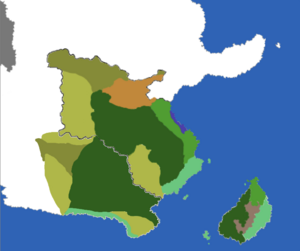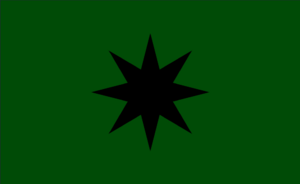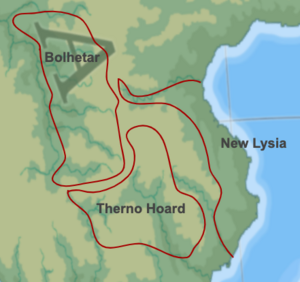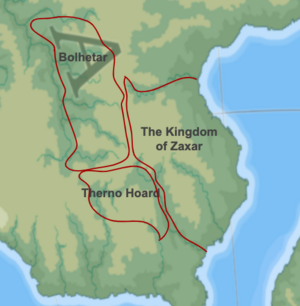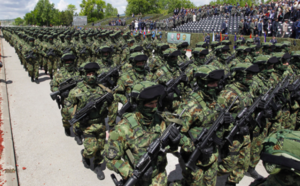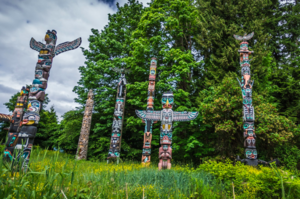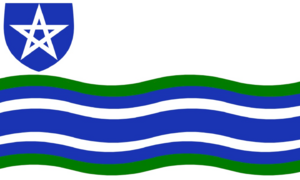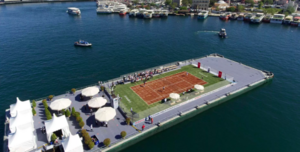Zaxar
Zaxar | |
|---|---|
| Motto: "From the Blizzard, a Blank Canvas" | |
| Anthem: "March of the Greens" | |
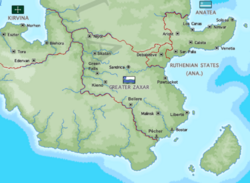 Map of Greater Zaxar | |
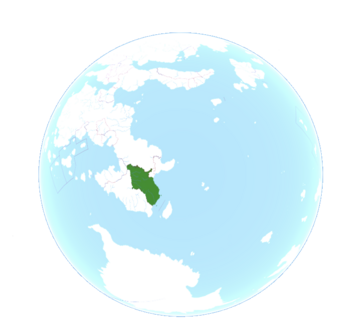 | |
| Capital and largest city | Sandrica |
| Official languages | Wampanoag, Lysian |
| Ethnic groups | Zaxar (47%), Wampanoag (30%), Lysian (10%), Other Native Aurelian (9%), Kirvinian (2%), Other (2%) |
| Demonym(s) | Zaxar |
| Government | Absolute monarchy |
• Emperor | William Zaxar |
• Empress | N/A |
• Crown Heir | Benjamin Zaxar (brother) |
| Legislature | Zaxar Senate |
| Establishment | |
• Wampanoag Empire | 1000 CE |
• New Lysia | 1523 CE |
• Kingdom of Zaxar | 1803 CE |
• Empire of Greater Zaxar | 2000 CE |
| Area | |
• | 778,000 km2 (300,000 sq mi) |
| Population | |
• Estimate | 10,500,000 |
• 2023 census | 10,500,000 |
• Density | 13.5/km2 (35.0/sq mi) |
| GDP (PPP) | estimate |
• Per capita | 25,000 ω |
| GDP (nominal) | estimate |
• Total | 57,881,250,000 ω |
• Per capita | 5,512.50 ω |
| Gini | 37.6 medium |
| HDI | 0.8521 very high |
| Currency | Wampum Mark (ω) (ZAX) |
| Date format | dd/mm/yyyy |
| Driving side | right |
| Calling code | +617 |
| Internet TLD | .zxr |
This article is incomplete because it is pending further input from participants, or it is a work-in-progress by one author. Please comment on this article's talk page to share your input, comments and questions. Note: To contribute to this article, you may need to seek help from the author(s) of this page. |
The Empire of Greater Zaxar, often referred to internationally and by locals as Zaxar, is a sovereign nation located in the southeastern Aurelia on Eurth. Zaxar's capital city is Sandrica which is located on the banks of the Glenne River and boasts a population of just over four million inhabitants. Zaxar is bordered to the west by Kirvina, to the northeast by Anatea, to the north by Louvier, to the south by Côte de Fourrure and to the east by the Adisi Ocean. The Zaxar city of Bostar is recognized as the southernmost city in the Wurld. The Empire has a population of 11 million, which is fairly urbanized, with just over half of the population concentrated in the nine largest cities. The population is largely concentrated in several distinct regions including the Sarthus River Basin, the southern coastline, and the foothills surrounding Niyol. The total area of the Empire is 778,000 square kilometres (300,000 sq mi). The official languages are Wampanoag, which is the most commonly used language, and Lysian, which is mainly spoken along the northeastern coast and in the city of Pawtucket. There are several other minority languages and dialects, mainly among the non-Wampanoag native Aurelians of southwestern Zaxar. The Empire has no official national religion, although Totemism is practiced by the vast majority of the country, including the royal family.
Zaxar is a full and prominent member of the Aurelian League. Zaxar maintains XX seats in...
The Empire of Greater Zaxar is a dynastic absolute monarchy under the Zaxar Dynasty, although Zaxar does have an elected senate which has no real power and serves instead as a representitive advisory council to the Emporer. The current ruler is Emporer William I Zaxar, who has ruled Zaxar since his father's retirment in the year 2000. The financial capital of Zaxar is the historical port city of Bostar, although it appears as if it will soon be overtaken by the rapidly growing mining city of Niyol. Zaxar has been around in some form for hundereds of years although it only recently joind the Wurld stage after the end of its unification war in 2000 CE. Today Zaxar is an emerging power on the Wurld stage and it is currently experiencing rapid economic and social growth as it recovers from the end of its bloody unification war.
The Greater Zaxar economy is considered to be somewhat weak at the moment although it is currently experiencing rapid expansion which has caught the eyes of several foreign investors. The economy is largely supported by the agriculture and aquaculture industries with significant contributions from the newly emerging lithium mining sector which is often considered by experts to be the single most promising opportunity for the growing Zaxar economy. Zaxar maintains positive diplomatic relations with all of its Aurelian neighbors while also having embassies and economic ties established with the most nations. Zaxar is currently working to expand its diplomatic corps and the Emperor has expressed his interest in creating closer economic and political ties with his Aurelian neighbors with a focus on the establishment of the Aurelian League.
Etymology
The name Zaxar comes directly from the dynasty of the first ruler of the nation, Robbert Zaxar. The name Greater Zaxar came about in order to differentiate the new united kingdom’s name from the former Kingdom of Zaxar which was William Zaxar’s birthplace.
The standard way to refer to a citizen of Greater Zaxar is as Zaxarian or as a Zaxar.
Regional and Local
There is great diversity in local and regional naming in Zaxar. The competing and combining influences of the Lysian, Kirvinian, and Wampanoag languages as well as the creolized Zaxari language are interspersed in the names of towns, cities, and regions. However the majority of rivers and other natural sites are named from local native groups with the exception of the Sarthus River, with its name a creolization of Wampanoag and Kirvinian.
Geography
The nation of Greater Zaxar is located in the southernmost reaches of the globe with Bostar being the southernmost city in the Wurld. It is because of this that most of the nation experiences frigid winters with large amunts of percipitation and temperate summers which allow for a short but productive growing season.
The majority of the country is covered by rolling hills of taiga forests enclosing large valleys. These valleys are home to Eurth's largest birch forests and these white birch trees are often included in tourists' bucket lists, especially during the fall months when the valleys transform into great seas of color as the leaves turn.
Zaxar’s larger landscape can be defined by its two main geographical features: the taiga forests in the east and the southern reaches of the Great Aurelian Steppe in the west.
The taiga forests, also known as boreal forests, cover a vast area in the eastern part of the country. These forests are characterized by dense stands of coniferous trees, such as pine, spruce, and fir, interspersed with wetlands and lakes. The taiga is home to a diverse range of flora and fauna, including species such as moose, reindeer, bears, and wolves. It is also an important breeding ground for migratory birds, making it a critical area for birdwatching and research.
To the west of the taiga forests lies the Southern Aurelian Steppe, a vast plains region that extends for hundreds of kilometers. The steppe is the tailpiece of the colossal Aurelian Steppe that spans the continent from the wastes in the north to the Tengrol coast in the east and finally down to the Southern Aurelian Coast. The steppe is characterized by vast grasslands, with scattered shrubs and trees. It is a unique landscape that supports a wide range of wildlife, including herds of wild horses, elk, and various species of birds.
Climate
Zaxar’s east experiences a subarctic climate in the taiga forests, characterized by long, cold winters and short, cool summers. The average temperature in the winter months can drop well below freezing, and heavy snowfall is common. In the summer, the temperatures are relatively mild, with average highs reaching only a few degrees above freezing.
The climate in the Southern Aurelian Steppe is heavily influenced by glacial runoff and the movement of weather patterns from the Gulf of Auriel, characterized by temperate, wet summers and frigid winters. The steppe receives relatively low precipitation, with most of it falling during the summer months. Summers mirror more temperate climates, with high temperatures often reaching 30°C (86°F) several times a year, while winters tend to be harsh, with temperatures dropping below freezing.
Population
Zaxar as a whole is sparsely populated, with scattered cities mainly concentrated in the western regions of the country and along the coast.The few large inland cities that do exist are clustered along the major rivers that have always been the lifeblood of the nation.
This powerful and diverse climate has led the native population to have a deep cultural connection to the land and its resources, and traditional Zaxari and Wampanoag practices reflect a harmonious relationship with the environment.
Conservation
The Eastern Aurelian Region is recognized for its significant ecological value, and efforts have been made to protect its unique natural features. Several protected areas, including national parks, nature reserves, and wildlife sanctuaries, have been established in the region to safeguard its diverse flora and fauna. These areas provide critical habitats for endangered species, such as the Aurelian Sheesh (Eudyptes aurelius), a species of penguin found exclusively in this region. The pine barrens biome along the coast is characterized by sandy, acidic soils and is dominated by pine trees, particularly the Aurelian Pine (Pinus aurelia), which is well adapted to the coastal conditions. The Aurelian Sheesh, also known as the Zaxari Penguin due to its strong historical ties to the nation, has adapted to this unique habitat and relies on the pine forests for nesting and foraging.
In the northern part of Zaxar along the Glenne River, there is a large birch forest ecosystem. Birch trees, particularly the Aurelian Birch (Betula aurelia) and the Zaxari Aspen (Populus Zaxarii), dominate this area and create a picturesque landscape with their striking white bark and vibrant yellow foliage in the fall. The birch forest is an important habitat for various wildlife species, including birds, mammals, and insects. It provides nesting sites for migratory birds and offers a food source for animals such as moose, reindeer, and foxes.
Challenges and Conservation Efforts
The Eastern Aurelian Region faces several challenges in terms of conservation and sustainable management of its natural resources. Human activities such as logging, mining, and infrastructure development that are subsidized by the Zaxari government as part of its great modernization program have had adverse impacts on the delicate balance of the region's ecosystems, including the taiga forests, pine barrens, and birch forests. Toxic dumping from lithium extraction sites were once a major issue in Zaxar but recent crackdowns and the expansion of the Ranger Corps have all but eliminated this issue in the nation.
There have been major efforts under the Zaxar Dynasty to promote conservation and sustainable resource management in the Empire. National parks, nature reserves, and wildlife sanctuaries have been established to protect critical habitats and species. Local communities, indigenous people, and other stakeholders are also actively involved in conservation initiatives, promoting sustainable practices and traditional ecological knowledge. Research and monitoring programs are conducted to better understand the region's ecosystems and guide conservation efforts. Many international universities have ecologic research stations in Zaxar as the government and people are proud of their environment and are therefore very culturally open to showing it off.
Tourism and Recreation
Greater Zaxar also offers opportunities for tourism and recreation, attracting nature enthusiasts, researchers, and adventure seekers. The region's unique landscapes, such as the taiga forests, pine barrens, birch forests, and the Southern Aurelian Steppe, provide opportunities for hiking, camping, wildlife viewing, and birdwatching. The coastal areas with their pine barrens and the presence of the Aurelian Sheesh penguin are particularly popular among tourists and researchers interested in avian ecology. The region's rich cultural heritage, including traditional Wampanoag and other indigenous lifestyles, as well as the heritage of early Lysian settlers, also provide opportunities for cultural experiences and eco-tourism.
Zaxar has been cited as a “fascinating destination for those interested in the natural world and cultural experiences” by Glubal Traval Review 2023.
History
Before the idea of the nation of Zaxar had even been conceived, the vast lands which the nation encompasses today were in chaos. Politically fragmented for much of its history, the land was ruled by hostile native clans and kingdoms who constantly sought to undermine and destroy each other through bloody warfare, genocide, and backstabbing. Little, in detail, is known about this period before 200 CE due to the frequent book burnings brought about through the warfare and much of what we do know comes from myths and legends passed down through stories and songs and the accuracy of these oral “histories” is largely considered unreliable by scholars. The holy grail of Zaxar’s more modern history is La Histori Del Sur which is a well sourced and thorough history of the Kingdom of Zaxar from 1536-1841 written by the famed Zaxar historian Codin Maxillo and published in 1843. This is where most of our knowledge of Zaxar’s founding and early history comes from. From earlier times, we mainly find information on Zaxar from Kirvinian sources as well as some sources from Zaxari scholars who were educated in Kirvina and translated the Wampanoag language into the Laimiaic Script used by the Kirvinians with only slight modifications as Wampanoag had no independent writing system.
First Nations (100 BCE - 1000 CE)
The land which is today known as Zaxar is somewhat isolated, with it being the southernmost country on Eurth and having a long history without Europan involvement.
The first true civilizations established in Zaxar were the Latazeca (100 BCE) and Opatomal (15 BCE) Clans located along the eastern bank of the Sarthus River (known as the Sagraphas in Kirvina). These were sedentary agricultural peoples who relied heavily on their staple crop, corn, for survival. These clans would go on to expand along the fertile Sarthus Valley and eventually settled most of the river basin.
Eventually, a series of earthquakes, floods, and fires would cause the collapse of the Latazeca and Opatomal civilizations around the year 300 CE, which quickly dissolved into hundreds of smaller tribes. These tribes soon developed their own unique cultures heavily based off their respective geographic locations. The tribes would, however, continue to practice very similar proto-totemist religions and had common linguistic roots which allowed for fairly thorough trade and communication to continue between the tribes.
The most notable of these clans were the Varus, the Guine, the Tolchar, and the Mahran. Around this time is also when the most important of the clans formed just south of the Sarthus River in the Glenne River Basin, the Wampanoag. By 730 CE, these 5 clans had managed to unite and consolidate most of the smaller clans, which led to the approximate division of land shown above.
It was also at about this time that a four way conflict started between the Sarthus River Clans, presumably over the division of Guine lands, as they were the weakest of the four. As the Guine War dragged on, it opened up an opportunity for the Wampanoag Clan to invade their normally stronger western neighbors. And invade they did, after just two years the elite Wampanoag Wolf Warriors had crushed the forces of the other clans and expelled their peoples from the Sarthus Basin entirely. This total victory left the Wampanoag as the sole superpower of the Greater Zaxar region and inspired their leaders to continue the conquest for generations to come.
First Empire (1000-1523)
Throughout the eleventh century, Wampanoag continued to expand across the region. Most of their expansion and annexation was done entirely without violence as their Wolf Warriors were so feared by their much smaller neighbors who had heard rumors of a brutal genocide committed by Wampanoag against the Mahran peoples. While these rumors are very likely untrue as there is no historical evidence of it, it is thought that the rumors were propagated by Wampanoag itself in order to intimidate its enemies.
By the year 1100 CE, the Empire had reached its greatest extent in territory, with it stretching nearly to Zaxar’s modern borders, controlling nearly all the major population centers in Zaxar of the time. The culture and traditions of Wampanoag also largely developed during this time, with famous cultural sites such as the Sandrica Bridge and Bostar Lighthouse being built. Facing no real external threats, Wampanoag had time to develop its economy as well, with the first fisheries and oyster farms being developed. Many of which are still in use today, as the aquaculture practices of these early farmers have been ingrained into the greater Wampanoag culture. This time period is often considered by historians to be the first Zaxar Empire, despite the people of this time having never even met an Europan yet. However, that was all about to change and bring with it devastating consequences for the Wampanoag people.
Colonization and Conquest (1523-1800)
The Wampanoag rulers had long known about the Europan colonists of neighboring Kirvina and Côte de Fourrure and had often traded with them through third-party clans and tribes, unknowingly building up the natural immunity of the nation against Europan diseases. There was still, however, a large outbreak of smallpox when the first Europan ships arrived at Wampanoag shores. The first Lysian settlers arrived after the Fearannth seizure of the Lysian colony Côte de Fourrure. This seizure led to thousands of Lysian soldiers and merchants fleeing north to seek protection from the local Wampanoag leaders. These refugees quickly assimilated with the natives and rose through the ranks of the military and government. During the collapse of the Wampanoag Empire, mainly due to infighting among the royal family, they managed to carve out a small kingdom for themselves along the coast of the Wampanoag Sea and settled in, marrying the local Wampanoag peoples and adopting much of their culture. It was during this time when the Empire participated in the Louvian Revolutionary War (1758-1761). The Wampanoag Empire backed the Louvians in an attempt to undermine Lysian colonial power and as part of their Star of Aurelia Doctrine which aimed to see all colonial powers removed from Aurelia. The Wampanoag Navy was of particular importance in the war as it saw its first ever sustained naval conflict and managed to inflict the first ever naval defeats on a colonial power in Aurelia by a native nation. This war is believed to have heavily influenced the modern Zaxari Naval Tradition.
The collapse of the Wampanoag Empire was a rapid decline between 1773 and 1797, with the official dissolusion of the Empire being announced in December 1798, with the last of the royal family fleeing to the island of Wampano where he would found a new kingdom, leaving the remainder of the empire to fragment into several small states.
It only took about ten years after that however, for three powers to come out as dominant in the region: New Lysia ruled by the Lysian Drogt Family; Bolhetar, ruled by the decendants of the Tolchar Clan, in the west; and the Therno Hoard in the south. New Lysia was, at first, the most populated of the new states and was the richest through trade with countries across the Adisi Ocean. Bolhetar was an agricultural society and pioneered the use of irrigation in the Sarthus River Basin as well as opening up trade with nations in the west by shipping their surplus grain down the Sarthus River; this trade with nations such as Rhodellia and Kirvina gave Bolhetar access to foreign investment and aid that would become crucial to its future. The Therno Hoard was a pastoral society where life revolved entirely around the raising of sheep, goats, and horses. This turned Therno into the most feared of the three nations, as their cavalry was thought to be the best in Aurelia. They were also known to frequently conduct raids on New Lysian and Côte de Fourrureian villages, stealing both women and supplies.
Direct wars between the three powers were infrequent and mostly limited to proxy wars and local militias along border regions. This balance of power would not last forever, though, and would soon lead to the war that would shape Zaxar for generations to come.
Revolution and [napoleonic wars] (1800-1926)
In New Lysia, contrary to one would expect, there was very little ethnic and racial tension. This was due in part to the accepting and friendly nature of the Wampanoag people, although mostly because when the Lysian settlers arrived in Zaxar they brought very few women. This forced the Lysians to marry into the natives, which fast tracked their assimilation, as children born with one Wampanoag parent and one Lysian parent were treated as equals to both the Europans and the natives. This mixing of cultures and ethnicities led to the creation of the unique Zaxar culture and race, which will be discussed in detail in a different section.
Such a lack of ethnic tension is not to say that there was no tension in New Lysia. The king of New Lysia, a Lysian general by the name of Drogt, had imposed harsh taxation and restrictions on the natives and children without a direct Lysian parent despite popular support for equality on both sides. This ultimately led to the Zaxar Rising of 1800 where a young mixed man led thousands of Wampanoags and Lysians in a march on the Pawtucket Palace where the royal family was residing. The revolutionaries and loyalists fought in the streets of Pawtucket for over two years, while fighting spread across New Lysia as loyalist forces attempted to wipe out the revolutionaries and those who had allied with them. Finally, in early 1803 Drogt was killed and thus the war ended. According to legend, he was thrown from his horse and set upon by a pack of Wampanoag shepherds, who tore his head from his body. However, most historians agree that he was drowned trying to flee across the Glenne River after his palace fell to the revolutionaries.
During the final surrender of the loyalists after Drogt’s death, the people of New Lysia came together to vote on their new king. And with over ninety percent of the vote, a young half-Lysian revolutionary leader took the throne, King Robbert Zaxar ‘The Chosen’. And the Kingdom of Zaxar was born.
Robbert’s reign was focused mainly around social reform and improving the lives of the people, both the natives and the Lysians. Throughout his reign, roads were built connecting the kingdom, the land of former Drogt nobles was divided up among the pheasants, and currency reform was enacted to curb inflation. Robbert’s reign lasted from 1803 until his retirement in 1843 at the age of 65.
The next Zaxar monarch to ascend to the throne was Hectal Zaxar who came to power at age 30 after his father’s retirement in 1843. He was selected by his father for his strong financial skills and his charismatic nature, which had originally made him a competent diplomat. Hectal’s reign was one of great prosperity for Zaxar with it being known as the “Great Peace” by historians. This peace was brought about due to the alliances and trade deals created by Hectal which brought great profit to the Kingdom and was the only true period of peace the kingdom had between 1523 and 2000. Hectal retired in 1890 at the age of 77 and is known as Hectal the Diplomat.
After his retirement, Hectal’s daughter Olivia Zaxar was his choice to become the first queen of Zaxar. Olivia’s main concern when coming to the throne was the establishment of an army which could cement Zaxar as the dominant power in the region. She used the vast amounts of wealth left over from her father’s reign to create Zaxar’s first standing professional army, as well as expanding and modernizing Zaxar’s merchant navy. To test this new army, Olivia launched several invasions into neighboring kingdoms, which were met with large amounts of success, allowing the establishment of several Zaxar vassal states and the annexation of large amounts of territory. Olivia “the Conqueror“ reigned from 1890 until her death in 1926 at the age of 56.
Flaxzar War (1926-2000)
After his mother’s death, young Prince Kenneth Zaxar took the throne and immediately was attacked by his two largest neighbors and rivals, the Kingdom of Bolhetar and the Therno Hoard. All of Kenneth’s rein was spent fighting this war, which is now known as the Great Flaxzar War due to the initial invasion by the Therno Hoard being launched across the Flaxzar River in 1926.
The first true battle of the war took place on 12 May 1926, when a Zaxar force of 12,000 men attempted to halt the Therno Hoard at the Battle of Malinsk. The Therno cavalry charged and, with the Therno forces numbering nearly 100,000, Zaxar forces dug in. The Zaxars inflicted heavy casualties on Therno but were overrun in a matter of hours. Malinsk had fallen and Therno continued their advance, taking Beliere and Bostar by 1927.
Meanwhile, the Bolhetar forces crushed down from the north and were stopped only just short of reaching Sandrica at the Battle of Black Ridge, which is immortalized in the poem ‘The Green Wall’ by Varska Leon.
These rapid successes by the Bolhetar and Therno forces shocked the people of Zaxar who had previously thought Zaxar to be the sole power of the region. King Kenneth at this time ordered the first conscription laws in Zaxar’s history, which required any man between 18 and 40 to serve a four-year term in the military. This was possible in Zaxar because women were able to fill most of the workforce as, unlike most other cultures of the time, women were viewed as equals to men in all jobs but fighting in Wampanoag culture.
As Zaxar’s strength grew, the enemy advance slowed and, around 1929, settled into trench warfare. As casualty numbers grew, the combatants began to feel the economic pressure of having so many people out of the workforce. To combat this, Zaxar increased trade across the Adisi Ocean, using its powerful navy to stop Therno from doing so as well. Bolhetar however, was able to continue trade as normal, trading grain with Kirvana and Rhodellia in exchange for modern weapons and equipment. This allowed Bolhetar to launch a surprise offensive in the spring of 1931 which caught the under equipped Zaxar troops off guard. Sandrica was encircled and besieged, while the Zaxar forces were forced to retreat all the way to Pawtucket.
The war was not looking good for Zaxar, at this rate they would be forced to surrender in a matter of months. The Zaxar high command knew something had to be done, so they planned for a last ditch attempt to defeat the Therno Hoard. The Therno forces had achieved great success at the beginning of the war, but now they were short on manpower, guns, and food as they struggled under the Zaxar blockade. Their army of mostly cavalry was not well suited for trench warfare, and high command was used to swift victories. So when Kenneth ordered the Bostar Offensive, it smashed the Therno forces, killing several high Therno commanders and sending the Hoard into a full-scale retreat. The Zaxars pursued the Therno army all the way back to the Flaxzar River, where they surrendered to Kenneth on 5 July 1936.
This victory brought morale back to the public and gave Zaxar new guns with which to sustain the brutal trench warfare of the Bolhetar front. The slow trench warfare continued in full swing for the next 20 years, with very few gains and very high casualties on both sides. Sandrica would continue to hold out against the Bolhetar siege and managed to never fall into enemy hands for the duration of the war.
From 1956 to 1983 there was a period of relative quiet and peace along the front as both sides lacked the manpower and will to launch any new offensives. This period is known as the ‘Eye of the Storm’ by historians and marked the turning point in the war, as Zaxar scientists and engineers used this time to leap ahead of Bolhetar in military technology.
In 1983, Zaxar high command finally was ready for the final push to end the war. A massive Zaxar force of around 700,000 men along with new tanks and planes developed during The Eye was prepared along the Bolhetar front. On 1 October 1983, the invasion commenced. Bolhetar held firm, but the Zaxar advance was brutal and unrelenting. A string of victories at the battles of Grend Springs (1983), Lankato (1984), and Opatoma (1984) pushed the Bolhetar forces back to the Sarthus River by 1985. The next 15 years were spent fighting a guerilla campaign against the remaining Bolhetar forces, who were supported by Rhodellia through munitions and intel. Bolhetar finally surrendered on 31 December 1999 and the Flaxzar War officially ended the next day on 1 January 2000 with the Peace of Sandrica. Casualties are estimated to have been between 40 and 60 million deaths over the course of the war.
Unification and Recovery (2000 CE - 2021 CE)
The Treaty of Sandrica was signed by Zaxar, Bolhetar, and Therno on 1 January 2000. This treaty unified the three nations under the banner of Zaxar which was changed to Greater Zaxar to acknowledge the equality of Bolhetars, Zaxars, and Thernos under the new rule as well as declaring Zaxar to now be The Empire of Greater Zaxar rather than a mere kingdom. Immediately after the treaty had been signed, Kenneth “the Great” retired at age 83 being the longest reigning monarch in Zaxar’s history, ruling an impressive 73 years. This left his son, Emperor Maxwell I Zaxar, to become the first Emperor of Greater Zaxar. Maxwell's reign was not a long one however, as he retired at the old age of 70 in 2020 stating in his retirement speech that he would rather his “modern” and “brilliant” son take the throne rather than “an old and behind the times man like me” (Maxwell I of Zaxar). Maxwell's reign was mostly spend rebuilding the shattered infrastructure of the nation and building up a sizable navy, which he hoped to use to protect Zaxar shipping in the event of another war.
After his father's retirement, William I Zaxar was crowned Emperor of Greater Zaxar on 2 October 2020. William has spent the first year of his reign attempting to rapidly modernize Zaxar as well as forging a new national identity which all Zaxar citizens can unify behind. This brings us to Zaxar today, which has fallen behind its neighbors in technology, has population shortages, lacks infrastructure, and whose economy is still in shambles due to 73 years of total war of unification. However, the light is visible at the end of the tunnel for Zaxar as through William’s strong leadership and the unified power of the people, Zaxar is set on a path to flourish.
Government and Politics
(WIP. Which government services exist? What is the name of your police? Foreign affairs, alliances, membership of international organizations.)
The Empire of Greater Zaxar is an absolute monarchy ruled by the Zaxar dynasty. Unlike most monarchies, in Zaxar a monarchy rarely rules for life. Although their rule is guarenteed for life, Zaxar tradition dictates that a monarch retire retire at some point, often in their sixties. It is not unheard of for monarchs to rule much longer however, as the longest reigning monarch, Kenneth "the Great" Zaxar, ruled 73 years during the Flaxzar War. The absolute monarchy does not really face much opposition in Zaxar due to it holding a beloved place within Zaxar culture as well as the apparent benevolence and selflessness of the current Emporer. There are some minor anti-monarchist groups although they are currently very small and mostly supported by a few small Bolhetar villages in the northeast.
| The Imperial Cabinet | |||||
|---|---|---|---|---|---|
| Empress | (N/A) | The Empress, or Emperor if the Empress sits the throne, is the second most powerful person in Zaxar. The Imperial Cabinet is obliged to obey her commands at all times unless it directly contradicts a command from the Emperor. The Empress will also serve as Regent should a monarch accend to the throne before age 20. | |||
| Crown Heir | Benjamin Zaxar (brother of the emperor) | In order to prevent a succession crisis the Emperor must name an heir upon their initial accention to the throne. This can then be changed later at the Emperor's choosing. The Crown Heir is considered to be the Emperor's apprentice and is the third most powerful person in the Empire. | |||
| Minister of Defense | Leon Varxsos | In charge of the procurement and management of the armed forces of Zaxar. Takes orders from the Emperor and directs the Grand Admiral, Grand General, and Chief of the Airforce accordingly. | |||
| Grand Ranger | Maël Zaxar (cousin of the Emperor) | The Grand Ranger is the highest rank in the Ranger Corps and is appointed by the Emperor. The Rnager Corps is the national guard of the Empire and is seperate from the rest of the military in order to help prevent a military coup. The Ranger Corps also serves as the royal guard and its leadership is made up of soldiers faithfully loyal to the Zaxar royal family. | |||
| Economic Minister | Nicholas von Kenne | The economic advisor is in charge of the allotment and management of the national funds. They are also in charge of trade and taxation policy. | |||
| Foreign Minister | Maurice la Vaneu | The foreign minister of Zaxar is in charge of treaties and relation management with foreign nations. They are also in charge of embassy management and tourism within the Empire. | |||
The high court of the Zaxar government is the Grand Court which consists of 13 Grand Justices who are directly appointed by the Emporer and serve 5 year terms unless replaced by the Emporer sooner. This court is the second highest power behind the law in Zaxar with only the Emporer themself being able to overrule their decicions. The Grand Court is also in charge of establishing and administering regional courts. These regional courts are then in charge of establishing and administering local courts in major cities and towns within their region. Both regional and local courts are presided over by a judge who is elected by their respective region or city.
| Zaxar Senate | Party (seats) | Details | |
|---|---|---|---|
| GDP
(46) |
The Green Dawn Party is the largest political party in Zaxar and is considered to be socially mid-left and economically center-right. Key issues include adressing climate change, the creation and upholding of strict pollution laws, enacting pro-choice protection laws, and decreasing income taxes for businesses and employees. | ||
| NDP
(28) |
The New Democratic Party is the second largest political party in Zaxar and is considered to be both socially and economically center-right. Key issues include expanding the military, upholding family values, outlawing the use of recreational drugs, and increasing exports to bring in foreign currency. | ||
| TTP
(9) |
The Totemist Party is the third largest political party in Zaxar and is based largely off of the principals of the Totemist faith. It is considered to be both socially and economically moderate. Key issues include pacifism, upholding traditional Wampanoag values, expanding subsidies to the agricultural and aquacultural sectors, and expanding social security. | ||
| DEP
(8) |
The Deep Ecologist Party is the fourth largest political party in Zaxar and is considered to be quite far left on the political spectrum. Key issues include expanding the adoption of a socialist system, expanding democracy, increasing equality among all by reforming or replacing un-equal laws, and imposing very strict environmental and animal rights laws. | ||
| NFP
(7) |
The New Freedom Party is the fifth largest political party in Zaxar and is considered to be both socially and economically right. Key issues include expanding the military, restricting emmigration, creating large incentives for young couples to have children, and increasing Zaxar's self-sufficency. | ||
| NZP
(2) |
The New Zaxar Party is the sixth largest political party in Zaxar and is the smallest party to currently hold seats in the Senate. It is considered to be both socially and economically far-right. Key issues include dramatically expanding the military, enforcing traditional family values, strictly regulating immigration and emmigration, and expanding the borders of the Empire. |
The legislative branch of Zaxar is made up of the Zaxar Senate on the national level and of regional parliaments on the regional level. The Zaxar Senate has the power to draft new laws and budgets for approval by the Emporer. The Emporer does have to sign off on any new law or budget proposal made by the Senate, along with the power to draft laws and budgets themself, though this has happend few times in Zaxar's history, which ensure that the people can have a voice in their government while also allowing the Emporer to silence that voice if he or she determine it neccisary. This is not often the case although it does happen from time to time. The Senate acts more similar to a parliament than a standard senate with its 100 seats being distributed in proportion to the general vote share. This often leads to a fairly diverse Senate which requires the establishment of coalition voting blocks to draft laws.
Provinces
The Empire of Greater Zaxar is broken down into 9 subdivisions with minimal autonomy and self governence. Many of the borders follow cultural, geographic, or historic boundries though they were designed to all have similar populations as of 2000 CE.
MilitaryThe Zaxar Armed Forces (ZAF) is the military of Greater Zaxar. It consists of the Imperial Zaxar Navy, the Imperial Zaxar Army, the Imperial Zaxar Airforce, and the Ranger Corps. Though the Ranger Corps is very rarely used in combat roles and instead acts as a national guard. The ZAF currently consists of 47,000 active duty army soldiers with 57,000 reserves, 17,056 active navy sailors with 5,000 reservists, and 2,000 active duty airmen with 1,000 reservists. While these statistics only list personel under paid service, Zaxari conscription laws ensure that in a time of war, the ZAF can call on up to a third of the nation's population though it is very unlikely that it would ever do so. The IZA makes use of the M27 Infantry Automatic Rifle with M855A1 Enhanced Performance Rounds for all infantry units. Supplamented by the M107 .50 caliber Sniper Rifle for use by special forces and the army's sniper support units. The varients of these weapons used by the ZAF were designed and are manufactured in Zaxar for military use. Economy(Energy. Transport. Media. Exports and imports. International partners. Currency. Science & technology. Unemployment numbers. Tourism.) The economy of Greater Zaxar is small and rapidly growing. After the instability of the Flaxzar War, the country has made great strides in renewing and expanding the economy through the utilization of the pleantiful natural resources of the state. The largest sectors of the Zaxar economy are the agricultural sector, the aquacultural sector, the mining sector, and the budding pharmaceuticals sector. Zaxar maintains economic ties to several nations in Aurelia and across the Adisi Ocean. The national currency of Zaxar is the Wampum Mark. Most coperations in Zaxar are privately or publicly owned and operated with the government only monopolizing a few important sectors such as policing and the military.
EnergyThe agenda of the current Emperor is one that is heavily focussed on the use of green energy with a dramatic cut in fossil fuels. The country has been sucessful in completely eliminating the use of coal entirely and the Senate has passed several taxes on petroleum which have been sucessful in making green energy a more affordable option for the vast majority of personal and cooperate consumption. The green energy sector in Zaxar has been helped in particular by the large-scale lithium mining operations taking place around the city of Niyol which provides domestic vehical manufacterors with a constant and cheap supply of battery-grade lithium. The government has also worked to provide electric "gas stations" across the country and has banned the use of non-electric vehicals in the military with exceptions only for machinery manufactored before 2020. The Zaxar national power grid is run by the government and is considered to be very efficient and reliable. The national grid is powered by several large hydroelectric dams along the Glenne and Flaxzar Rivers which are owned and operated by the government as well. The other major power sources for the grid are the wind farms of eastern Zaxar. These farms were built in the early 2000s by Emperor Maxwell I and are located along the coast in order to provide maximum energy capacity. Biofuel has also been an important source of energy for the Empire. Domestic biofuels are derived from the discarded corn husk and wheat fibers from the agricultural sector of western Zaxar. This biofuel is mostly used domestically by farmers to heat their animals and facilities over the winter months. Nuclear energy is not heavily used in Zaxar yet although there have been government inqueries into investment. It is currently only used in lithium mining operations which may require large quantities of power. TransportNatural SectorIndustrial SectorEmploymentTechnology and InnovationInternational RelationsCurrencyTourismDemographicsCities
Ethnic GroupsThe population of Zaxar is consisted mainly of ethnic Zaxars, a mixture of Wampanoag and Lysian, with large communities of Wampanoags and Lysians as well. Small communities of other native groups can also be found in the southwestern regions of the country. Very little ethnic tension currently exists in the modern day, although it has been a point of tension in the recent past, namely during the Flaxzar War. LanguageThe national languages of Zaxar are Wampanoag and Lysian with the majority of the population being fluent in both. Road signs are all written in Wampanoag and a basic understanding of the language is often needed in order to obtain any skilled labor job in any city outside Bostar which is known to contain the largest immigrant population in Zaxar. ReligionZaxar does not have an official state religion, and the monarchy has been keen to avoid the entanglement of church and state. However, the vast majority of the country practices Totemism and Totemist holidays are considered to be national holidays. Major Totemist holidays include Ancestors Day, which is celebrated on October 31 with parties and totem carving ceremonies, and the Renewal Days wich are celebrated on every solstice with twenty-four hours of partying and celebration with friends and family. HealthcareThe life expectancy of Zaxar is 72 years, although it is projected to increase dramatically in the next few decades after the end of the Flaxzar war, which had dropped the life expectancy down to under 60 years of age. The leading cause of death is cancer as the Zaxar healthcare system, while defiantly not Wurld renowned, is developed enough to treat most diseases and prevent major epidemics. Zaxar does not offer state-funded healthcare, although there is government funded health insurance guaranteed for all citizens. EducationEducation wise, Zaxar is right about the middle of the pack for developing nations. Zaxarians enjoy on average 12 years of schooling, and it takes 16 years of schooling to achieve a master’s degree. Private colleges are allowed and make up the majority of universities across the country, although the state sponsors public universities with affordable tuition in every major city. One of the policies that makes the Zaxar university program stand out is that any man or women who choose not to go to university is required to instead serve for two years in the Zaxar armed forces or to serve in the Rangers Corps. The Ranger Corps is a student organization in charge of the maintenance and protection of Zaxar's many national parks, as well as the enforcing of environmental regulations across the nation through investigations and monitoring of private cooperations. The most famous university in Zaxar is the University of Green Falls (UGF) located in the city of Green Falls. UGF is a public university which offers entirely free tuition and is known to take only the brightest students Zaxar has to offer. Culture(Literature. Visual arts. Music. Cuisine. Art. Architecture. Entertainment. Music & Radio. Television. Local customs. Clothing. Morality. Sports. Stereotypes. Your national symbols such as the flag and national anthem. Public holidays and festivities.) National SymbolsThe national animal of Zaxar is the Aurelian Sheesh, also known as the Zaxari Penguin. The bird has long been a prized pet for the Zaxari royalty in a tradition which roots back to the coronation of King Robert I 'the chosen' Zaxar when it is said that the new king's pet sheesh was included in his royal portrait which has displayed in the Sandrica Palace ever since. The national tree of Zaxar is the XXX The national flower of Zaxar is the XXX CuisineThe cuisine of Zaxar is largely based off of fish and hardy grains which are the both natively abundant in the area. Corn is considered to be the staple crop and is used for both flour and animal feed. Corn is grown over the dry summer months in the fertile river basins of the Sarthus and Glenne Rivers and then stored for winter consumption. Fish is the main protein of the Zaxari diet and is supplied by large fisheries off the coast. Fish farming, or aquaculture, is a long-standing tradition in Wampanoag culture and fish are used in many important ceremonies. The most abundantly farmed fish are trout, salmon, and cod while the most common wild caught fish are herring are flounder. The only common food-animal raised in Zaxar is elk (known as wôboz in Wampanoag) due to the harsh climate of the Zaxari winter months. These elk are raised primarily their meat which is often consumed as sausages or in stews. However, elk are also utilized for their antlers, used in traditional jewelry; their milk and cheese, eaten plain as well as being used in many Zaxari dishes; and hides, used to create blankets and in the manufacture of traditional clothing. The most popular alcoholic drinks in Zaxar are fermented elks' milk, called wôbissisit, and cider which is grown on thousands of small, family orchards in the more temperate northern regions of Zaxar. The most common type of cider in Zaxar is apple but pears and other orchard fruits are often used on their own or in combination with the apple cider. Other notable Zaxari crops include beets, carrots, turnips, radishes, cabbage, and potatoes which are grown primarily in the less temperate Flaxzar and southern Sarthus River basins. The national dish of Zaxar is the Bostar Clam Chowder which was supposedly invented in the early days of Europan settlement in the city of Bostar, which was a part of New Lysia at the time, when a young Wampanoag woman combined the hardy chowder of the Lysian settlers with the traditional clam stew of the Wampanoag. From there, according to legend, the food took off across Zaxari culture and came to be seen as a food of friendship and unity in Zaxar culture. The recipe for the nationally recognized version states that it is to be served in a bread bowl or with oyster crackers in order to include the many small native tribes apart from the Wampanoag who farm wheat along the Sarthus. VexillologyThe original flag of Greater Zaxar was first designed in the year 2000 by Alex Chabule as a submission to the Greater Zaxar flag contest held to find a new flag for the new nation. The white background represents a blank canvas of snow for the purity and fresh start of the young nation after its years of war and political turmoil. The blue stripes represent the great lakes and rivers which provide food, power, and trade to nearly all the major cities of Zaxar. The smaller, green stripes represent the vast taiga forests and green valleys that cover most of the country. The star crest found in the top left of the flag represents the ruling dynasty of Zaxar, the Zaxar dynasty. The flag was created to replace the old Zaxar flag upon the unification of the country in order to promote unity among the citizens of Greater Zaxar. The modern flag of Zaxar was adopted on xxx upon the union of Greater Zaxar and the island of Wampano which marked the unification of the entirity of the Wampanoag people into a single nation for the first time since the fall of the Wampanoag Empire. This flag represents the union of the Wampanoag and Lysian people with the 8-pointed star, which combines the traditional black star of the Wampanoag with the traditional white star of the Zaxari and Aurelian Lysian peoples. This star is set on a forest green field which represents the vast wilderness and natural beauty of Zaxar which Zaxari culture holds in equal ,if not higher, import as the people of the nation. This can be seen in the traditional Zacari saying that "while the people make the nation, the land makes the people." This flag is also representitive of the evolution of Zaxar as a state away from an identity defined by the imperial dynasty, and towards one defined by a sense of national identity. SportsIn the Zaxar culture, ability in sports is highly valued among both men and women. The most prominent sports in the nation are soccer, American football, tennis, and combat sports. Combat sports are, in particular, very highly regarded, with Zaxar fighters becoming infamous across Aurelia. The premiere leagues for fighting in Zaxar are the ZMMA (Zaxar mixed martial arts), the WBT (Wampanoag boxing tournament), the SKB (Sandrica kick boxing), and the ZWC (Zaxar wrestling championship). The Zaxar football league (ZFL) currently has 22 teams with 2 teams from each major city. These teams compete over a series of 18 games before the top teams move on to the playoffs which work as single elimination to determine the champion. Soccer works similarly, with the ZSA (Zaxari Soccer Association) being structured the same way as the ZFL. The national soccer team of Zaxar is the Zaxar Tomahawks who are members of the SATAMFC League and compete in the UENA Football tounaments. The team is currently unproven on the Wurld stage though there are very high hopes for the Tomahawks as the team is one of the best in Aurelia and hopes to bring the first Wurld Cup back to Zaxar and to Aurelia. There are several important tennis tournaments in Zaxar as well as the Zaxar National Tournament. Notable tournaments include the Sandrica Open, the Pêcher Open, the Green Falls Tournament, and the Niyol Cup. The most unique tournament of these is by far the Green Falls Tournament which is played on floating tennis courts which are set up in the Green River. Major winter sports in Zaxar include wrestling, biathalon, and all forms of skiing. References & Tools
|
||||||||||||||||||||||||||||||||||||||||||||||||||||||||||||||||||||||||||||||||||||||||||||||||||||||||||||||||||


